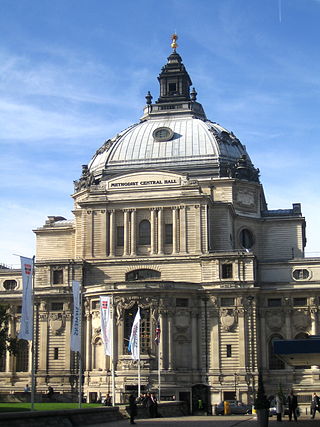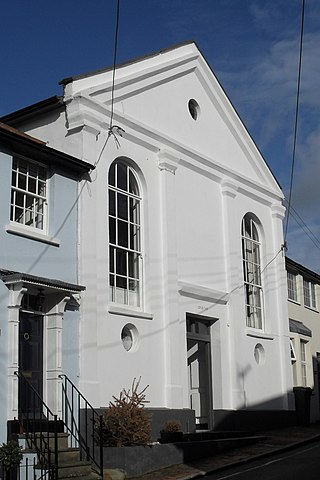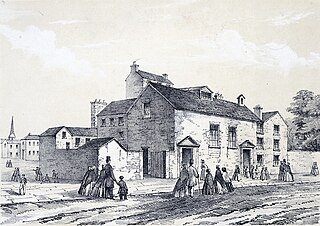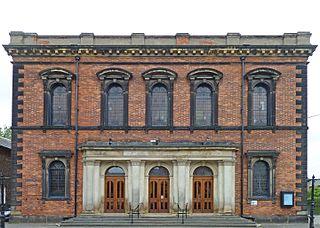Methodism, also called the Methodist movement, is a group of historically related denominations of Protestant Christianity whose origins, doctrine and practice derive from the life and teachings of John Wesley. George Whitefield and John's brother Charles Wesley were also significant early leaders in the movement. They were named Methodists for "the methodical way in which they carried out their Christian faith". Methodism originated as a revival movement in the Church of England in the 18th century and became a separate denomination after Wesley's death. The movement spread throughout the British Empire, the United States, and beyond because of vigorous missionary work, and today has about 80 million adherents worldwide.
The Methodist Church of Great Britain is a Protestant Christian denomination in Britain, and the mother church to Methodists worldwide. It participates in the World Methodist Council, and the World Council of Churches among other ecumenical associations.

Wesley Church is a Uniting Church in the centre of Melbourne, in the State of Victoria, Australia.

John Wesley's New Room is a historic building in Broadmead, Bristol, England. Opened in 1739, it housed the earliest Methodist societies, and was enlarged in 1748. As the oldest purpose-built Methodist preaching house (chapel), it has been designated by Historic England as a Grade I listed building.

Wesley Methodist Church is the oldest Methodist church in Singapore. It is the second Methodist Church to be built in Singapore after the Methodist Episcopal Church at Coleman Street which subsequently became a school hall. It is located in Fort Canning Hill.

The organisation of the Methodist Church of Great Britain is based on the principle of connexionalism. This means that British Methodism, from its inception under John Wesley (1703–1791), has always laid strong emphasis on mutual support, in terms of ministry, mission and finance, of one local congregation for another. No singular church community has ever been seen in isolation either from its immediately neighbouring church communities or from the centralised national organisation. Wesley himself journeyed around the country, preaching and establishing local worshipping communities, called "societies", often under lay leadership. Soon these local communities of worshipping Christians formalised their relationships with neighbouring Methodist communities to create "circuits", and the circuits and societies contained within them, were from the very beginning 'connected' to the centre and Methodism's governing body, the annual Conference. Today, societies are better known as local churches, although the concept of a community of worshipping Christians tied to a particular location, and subdivided into smaller cell groups called "classes", remains essentially based on Wesley's societies.
William Willmer Pocock was a British architect.
The Manchester and Salford Wesleyan Methodist Mission was set up in 1886 in Greater Manchester, North West England. The Central Hall building on Oldham Street became the head office for the mission. Before Central Hall was built, there was a previous chapel, which was opened by John Wesley in 1781. John Wesley and his brother Charles Wesley were the founders of Methodism in England in 1729; the Manchester and Salford Wesleyan mission was named after them, as were many other missions. There were “numerous and flourishing voluntary societies to combat vice, and religious societies to enlighten the faithful”; the society set up by the Wesley brothers in Oxford in 1729 was “to prove that the decline of the religious spirit had been exaggerated”. When the chapel in Oldham Street was demolished, it was replaced by the Methodist Central Hall.
The Wesleyan Methodist Church was the majority Methodist movement in England following its split from the Church of England after the death of John Wesley and the appearance of parallel Methodist movements. The word Wesleyan in the title differentiated it from the Welsh Calvinistic Methodists and from the Primitive Methodist movement, which separated from the Wesleyans in 1807. The Wesleyan Methodist Church followed the Wesleys in holding to an Arminian theology, in contrast to the Calvinism held by George Whitefield, by Selina Hastings, and by Howell Harris and Daniel Rowland, the pioneers of Welsh Methodism. Its Conference was also the legal successor to John Wesley as holder of the property of the original Methodist societies.

The Primitive Methodist Chapel is a former Primitive Methodist church on Welsh Row in Nantwich, Cheshire, England. Built in 1840, it is listed at grade II. The chapel closed in 2001, and the building has been partially converted to residential use.

Jarvis Hall is a former Nonconformist chapel in the village of Steyning, in the Horsham district of the English county of West Sussex. Since its construction in 1835, the Classical-style building has been used by four different Nonconformist Christian denominations: the Countess of Huntingdon's Connexion, Wesleyan Methodists, the Salvation Army and Plymouth Brethren. The Brethren occupied it last and for the longest time. After about 150 years of religious use, it was sold for residential conversion. English Heritage has listed the former chapel at Grade II for its architectural and historical importance.

Monmouth Methodist Church is located in Monmouth, south east Wales. It is set well back from St James Street between buildings. Designed by George Vaughan Maddox and built in 1837, it retains its original galleries, organ loft and sophisticated pulpit.

William John Hale was an architect based in Sheffield, England, who produced the city's most striking early 20th-century architecture. He practised between 1896 and 1929 and designed several schools and churches in Sheffield, using the Arts and Crafts and Art Nouveau styles as a basis.
John Wills was an architect based in Derby.

Hinde Street Methodist Church in Hinde Street, Marylebone, London, is Grade II listed with Historic England. It was built 1807-10 and rebuilt in the 1880s.

The Foundery, in Moorfields, was the first London foundry for casting brass cannon for the British Board of Ordnance. The building subsequently served as the first Wesleyan Methodist house of worship, and an important meeting place for the early Methodist community. In 1778, the Methodist congregation was moved to the nearby purpose-built Wesley's Chapel on City Road.

The Wesleyan Church is a former Methodist church for the town of Aldershot in Hampshire, England. Closed in 1988 the building has been a Grade II* listed building since 30 April 1981. In use today as offices, a dental studio and a gymnasium, the former Wesleyan Church is situated on the corner of Grosvenor Road and Queens Road in Aldershot.
Elijah Hoole was an English architect of Methodist churches, settlement halls and social housing. In relation to the social housing, he worked closely with the social reformer Octavia Hill for over 40 years.

The Wesley Chapel on Priory Street, in the Bishophill area of York, in England, is a grade II* listed building.















